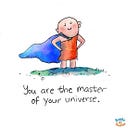How To Create a Book
Step by step from a Pacific Northwest illustrator and author
“Creating a book is like making a baby. But less messy, taxing, and genetically rewarding.”
Step one: Conception.
The idea to write a book is precious — a seed that needs water, protection, and support. The inspiration for this book came from a kayak journey from Victoria to Alaska (1700km). I kept journals along the way and when I came home I knew I had to do something. It was a deep-down gotta-do-it feeling. I had been initiated into a terribly beautiful world and felt a duty to translate my experience. I had to write.
But lots of people go on half-baked journeys and egotistically say to them self: “I must write a book!” Was this also my ego? In short, yes. But also it was a process. I kept telling myself: this book is to learn, not to publish. Lots of people make fantastic pies, but they don’t open a bakery. To share it with friends and family would have been enough. To share it with people around Canada is a privilege that has less to do about my ability writing and painting, and more to do with the countless people who supported me.
Step two: Evolution and care.
The book-idea is now an organism. It grows, feeds, expands, contracts, and at the beginning, needs constant care. Think breast milk, late nights, and early mornings. Actually it wasn’t so intense. But because I had no clue what I was doing, I had to learn new things: like how to paint less like a five year old, and how to write less like a angsty, arrogant 20 year old. I’m not sure I made much ground.
The real evolution came from feedback and time. I tried my book on over a hundred different people. I asked questions. I told them to be honest with me.
Some didn’t know what a kayak was, some did. In all cases I got new perspectives, and fed them back into the machine (book). I learned a lot about presentation, how to create emotions by combining text and images, being concise, and toning down my privileged, male voice.
Storyboarding is super fun and crucial to finding flow. It is the step where you have free license to dream, ask big questions, and go (slightly) crazy.
Step three: put it up for adoption.
At a certain point the book-creature is cute and mature enough to leave home and fulfil bigger dreams. AKA you must sell your kid. To be honest the reception from traditional publishers was strange. I’m not sure they knew what to make of the recipe, chart atlas, memoir, love-story, philosophy, coming-of-age, coastal medley. Heart warmingly, Heritage House took the baby on board. Thank you.
Also. I had already done alot of work on the book. Most publishers will want you to come in when you are still forming the content, flow, and look, so they can help guide the process.
Step four: Let go.
All parents must release and trust the process. My job is mostly done now. It took eight years, countless drafts, and two summers alone in a kayak. I learned I am good at making mistakes, lucky (privileged) to be born in an amazing province with supporters, and that I am incredibly small. Yes, I am this little barnacle, it’s the ocean that is big, and it’s the ocean that holds the stories. Really, this book is by the Pacific Ocean.
Once the publisher takes over it is on to marketing. All I have to do is make posts, be grateful, and keep letting go. I don’t expect much from this book — money wise or famewise. “Have super low expectations,” was the advice from a fellow publisher/translator. I like this. This was my first book, and I’m just happy to have done it. Already making the book has served its purpose by teaching me how to be a better person. For that I am grateful beyond measure.
https://www.heritagehouse.ca/book/a-complex-coast/#0
Thank you for reading.
Be happy.
dn
